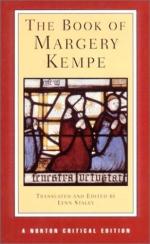|
This section contains 8,671 words (approx. 29 pages at 300 words per page) |

|
SOURCE: “Body into Text: The Book of Margery Kempe,” in Feminist Approaches to the Body in Medieval Literature, edited by Linda Lomperis and Sarah Stanbury, University of Pennsylvania Press, 1993, pp. 168-85.
In the following essay, Harding contends that The Book of Margery Kempe is a dialogue between Kempe's scribe, as a representative of the literate, celibate, male clerical segment of society, and Kempe, as a representative of a “disenfranchised class of illiterate, married women” who were not attached to a religious order. These historical and hierarchical oppositions, Harding stresses, are disrupted in Kempe's Book.
Since it was first made available to scholars in 1934, The Book of Margery Kempe has generally been analyzed and evaluated in terms of the contribution it makes to the corpus of medieval mystical writings. In this context, Margery Kempe's book is agreed to be interesting but finally somewhat derivative. As one of the first...
|
This section contains 8,671 words (approx. 29 pages at 300 words per page) |

|


